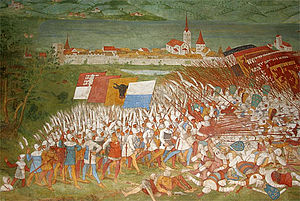Heap of four

Gevierthaufen , also Haufentaktik , was a military- tactical formation of the infantry from the 14th to the 17th century with the same number of fighters on all sides.
The ordinances of the Gevierthaufen , which perfected themselves with the Spanish Tercio , the Dutch ordinance up to the Swedish ordinance , was overtaken by the development of firearms and replaced by the more modern linear tactics .
Emergence
In the wars of the Swiss people's armies against the knight armies of the Burgundians in the 14th / 15th centuries. In the 19th century, the main element of the battle order of the infantry fighting in closed masses was the heaps. For battle, the Swiss usually formed three groups, namely the vanguard , the violent group and the rear guard , for which the so-called square became the norm in the course of the 15th century .
Further development
Since the last third of the 15th century, when the Swiss entered foreign service more and more frequently as mercenary troops , the Swiss Gevierthaufen, like the formation of the infantry in three groups, was taken over by the mercenary armies of other countries and developed into the tactical formation of infantry. In English-speaking mercenary armies, for example, the term pike square , a quite analogous translation for Gevierthaufen, was coined, which has survived in the following years.
Tactical formation
Switzerland
The heap of quarters was a tightly closed rectangle with 30-50 men side by side and one behind the other. With the Swiss it consisted of several members of philistines who were initially surrounded by lightly armed men with axes, hatchets and short swords, and later by halberdiers .
- Pile of Swiss pikemen, here a re-enactment of tactical formations on the Escalade de Genève
Figure 1 : Pikemen in "combat readiness".
The polearms are held in a vertical position close to the body, the heap has taken up position in the fighting square.
Figure 2 : Pikemen in "defensive position against cavalry".
The first row holds the shaft end of the polearms fixed to the ground. The pike points at an angle of approx. 30–35 ° upwards in the direction of the attacking opponent. The second row holds the polearms horizontally forward and provides "security and cover".
Figure 3 : Pikemen in "position of emergency ready to attack".
The first row holds the polearms horizontally ready to push at shoulder height in the direction of the opponent to be attacked. The second row holds the pikes “diagonally upwards” to avoid injuries to the pikemen in the first row and in readiness to replace them. Under real combat conditions, both rows could comprise three to five members, depending on the length of the square and the number of personnel. All weapons therefore pointed towards the enemy and not towards their own combat formation.
Figure 4 : Pikemen in the square for "all-round defense".
The pikemen hold the polearms horizontally ready to push at shoulder height and thus protect the square in all directions at the same time.
Germany
The heap of four German mercenaries formed fewer and fewer halberdiers, philistines and pikemen . The captains and twin mercenaries usually fought in the first ranks, and the flags were in the middle of the heap of four. The later military rank of captain of the rank group of officers in German-speaking armies goes back to those captains .
Hedgehog formation, reenactment for the Landshut wedding
Combat tactics and replacement by line tactics
The Gevierthaufen tried to break open the opposing lineup with a powerful push, for which the first six members facing the opponent fell the spears, but after the collision mostly dissolved into lone fighters. In defense, especially against cavalry , all the outer limbs put the spears in front of them, so that a hedgehog with high defensive strength was created. At first the crossbow and rifle shooters swarmed loosely in small numbers in front of the front of the Gevierthaufens and played only an insignificant role in the battle .
With the rapid increase in the number of musketeers in the 16th century, new battle lines were created within the framework of the heaps to better combine thrust and firepower . These were established in the orderly .
The further development of firearms led to the gradual dissolution of the large piles of four into a larger number of piles of shallower depth. The introduction of the bayonet finally made polearms superfluous as infantry armament around 1700 . In place of the dense piles of pikemen and the musketeers who worked with them, there were long lines, 6–10 limbs deep, of the infantry, equipped exclusively with firearms.
The heap tactic was overtaken by the ever faster developing weapon technology and was finally replaced by the line tactic.
Individual evidence
- ^ Dictionary of German Military History, Military Publishing ... 1985, p. 254








